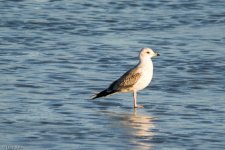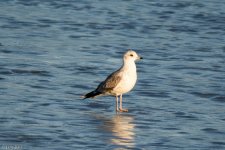-
Welcome to BirdForum, the internet's largest birding community with thousands of members from all over the world. The forums are dedicated to wild birds, birding, binoculars and equipment and all that goes with it.
Please register for an account to take part in the discussions in the forum, post your pictures in the gallery and more.
You are using an out of date browser. It may not display this or other websites correctly.
You should upgrade or use an alternative browser.
You should upgrade or use an alternative browser.
Gull ID, Helsinki (1 Viewer)
- Thread starter lbaia
- Start date
More options
Who Replied?Neil Morris
Well-known member
Yes indeed. Second calendar year bird.
Nutcracker
Stop Brexit!
Yes; first-summer (using standard terminology  ).
).
Yes; first-summer (using standard terminology).
I don't want to be obnoxious or anything, but out of curiosity: why are you calling it 'summer'?
Nutcracker
Stop Brexit!
I guess 'summer' tends to be used after the start of March; maybe first-winter might be more accurate.I don't want to be obnoxious or anything, but out of curiosity: why are you calling it 'summer'?
Neil Morris
Well-known member
For clarification, I used the term second calendar year because neither first winter nor first summer seemed most appropriate. The bird is largely in juvenile plumage.
SteveClifton
Well-known member
For clarification, I used the term second calendar year because neither first winter nor first summer seemed most appropriate. The bird is largely in juvenile plumage.
No, it's not largely in juvenile plumage! For starters it has extensive 2nd generation grey scapulars & clear-cut pale-based bill which makes it a 1st winter if you want to be pedantic like Nutcracker
I would have stuck with 2nd CY as you said at first, a perfectly sensible catch-all term which avoids any reference to the state of plumage a bird is in, which as you have discovered, can be confusing and misleading!
Last edited:
Summer does not start until 21 July...
Besides, "first-summer" refers to the plumage, not the time of year.
You would not call this owl a "first-summer" Eagle Owl simply because it was photographed in March, would you?
Why does summer start 21 July? That's almost autumn? Mid-summer's day is supposed to be June 21! The weather guys usually have summer start on June 1st.
Neil Morris
Well-known member
No, it's not largely in juvenile plumage! For starters it has extensive 2nd generation grey scapulars & clear-cut pale-based bill which makes it a 1st winter if you want to be pedantic like Nutcracker. Common Gulls don't really have a recognisable first summer plumage-just a faded version of 1st w.
I would have stuck with 2nd CY as you said at first, a perfectly sensible catch-all term which avoids any reference to the state of plumage a bird is in, which as you have discovered, can be confusing and misleading!
Er, other than a proportion of second generation mantle, scapular and some body feathers, the plumage is largely juvenile first generation. I guess I would normally refer to the bill as "bare parts" not plumage which I use when referring to feather tracts.
Common Gull does have a first summer plumage, being a "partial moult in spring. It starts in February and is completed by April, leaving birds in so-called "first summer" plumage." (Per Gull Research Org).
Why does summer start 21 July? That's almost autumn? Mid-summer's day is supposed to be June 21! The weather guys usually have summer start on June 1st.
My bad! I meant 21 June, of course.
SteveClifton
Well-known member
Er, other than a proportion of second generation mantle, scapular and some body feathers, the plumage is largely juvenile first generation. I guess I would normally refer to the bill as "bare parts" not plumage which I use when referring to feather tracts.
Common Gull does have a first summer plumage, being a "partial moult in spring. It starts in February and is completed by April, leaving birds in so-called "first summer" plumage." (Per Gull Research Org).
Neil, first apologies if my previous post came across as terse or sarcastic. That wasn't my intention, but can see that it might be possible to read it that way.
We can all agree at least on the first point, that this is a Common Gull! but since the OP asked, I think it's helpful to be precise about the language we use to describe its age.
I think it's normal (in Europe at least) to refer to plumage types that are recognisable in the field (e.g. juvenile, first winter, second winter etc). This of course includes first summer, in those species where that plumage type is clearly distinct from the others.
I agree that the subject bird does have a large proportion of juvenile feathers (juvenile, because they are the first set of proper feathers a bird acquires after the downy ones that young birds have as chicks) but the presence of the grey saddle, formed by moulting in second generation mantle & scapular feathers during the autumn, makes this recognisable as first winter plumage-so called because it is quite distinct from mainly brown, scaly plumage that we commonly call 'juvenile plumage'.
The clear distinction between the pink bill base and black tip are also different to most juveniles (which tend to be darker with less clear distinction between base/tip). Not feathers, I agree, but still the bill pattern on the subject bird is a distinct feature of what we refer to as 'first winter' plumage.
I have also read the accounts on the gull research.org site, and while they do refer to a so called "first summer" plumage (note the use of " " on that site), it's important to note that it isn't really distinct or recognisable from "first winter" except that the head and body feathers become whiter/less blotchy/streaky. In first winter, and indeed first summer plumage, many feathers are still (faded) juvenile feathers, but this does not in itself make the bird a 'juvenile'.
Sorry if this seems like just semantics, but as I said, with certain groups of birds it's important to be precise about exactly what constitutes each age class.
Last edited:
Neil Morris
Well-known member
Neil, first apologies if my previous post came across as terse or sarcastic. That wasn't my intention, but can see that it might be possible to read it that way.
We can all agree at least on the first point, that this is a Common Gull! but since the OP asked, I think it's helpful to be precise about the language we use to describe its age.
I think it's normal (in Europe at least) to refer to plumage types that are recognisable in the field (e.g. juvenile, first winter, second winter etc). This of course includes first summer, in those species where that plumage type is clearly distinct from the others.
I agree that the subject bird does have a large proportion of juvenile feathers (juvenile, because they are the first set of proper feathers a bird acquires after the downy ones that young birds have as chicks) but the presence of the grey saddle, formed by moulting in second generation mantle & scapular feathers during the autumn, makes this recognisable as first winter plumage-so called because it is quite distinct from mainly brown, scaly plumage that we commonly call 'juvenile plumage'.
The clear distinction between the pink bill base and black tip are also different to most juveniles (which tend to be darker with less clear distinction between base/tip). Not feathers, I agree, but still the bill pattern on the subject bird is a distinct feature of what we refer to as 'first winter' plumage.
I have also read the accounts on the gull research.org site, and while they do refer to a so called "first summer" plumage (note the use of " " on that site), it's important to note that it isn't really distinct or recognisable from "first winter" except that the head and body feathers become whiter/less blotchy/streaky. In first winter, and indeed first summer plumage, many feathers are still (faded) juvenile feathers, but this does not in itself make the bird a 'juvenile'.
Sorry if this seems like just semantics, but as I said, with certain groups of birds it's important to be precise about exactly what constitutes each age class.
No worries Steve.
I didn't use the term first winter because this individual has not yet reached recognisable definitive first winter plumage, and neither did I call it a juvenile as strictly it isn't.
Hence being the first to answer the OP I opted for the best alternative, second calendar year. This also best answered the OP's question, "what age is it?".
I'd argue that the scaps are also largely juvenile - I just can't see two tracts of large wholly grey feathers. I'd suggest that the bill pattern and colour is frequently seen on much younger birds in their first calendar year. GRO also refers to "so-called first winter plumage" because, as you rightly describe, moult stages are continuous, varied and overlapping, rarely completely discrete phases.
So I stick my two posts ... Second calendar year Common Gull in largely juvenile plumage. Personally, I feel this is far more accurately and factually descriptive than labelling it first winter.
Cheers
Users who are viewing this thread
Total: 2 (members: 0, guests: 2)





